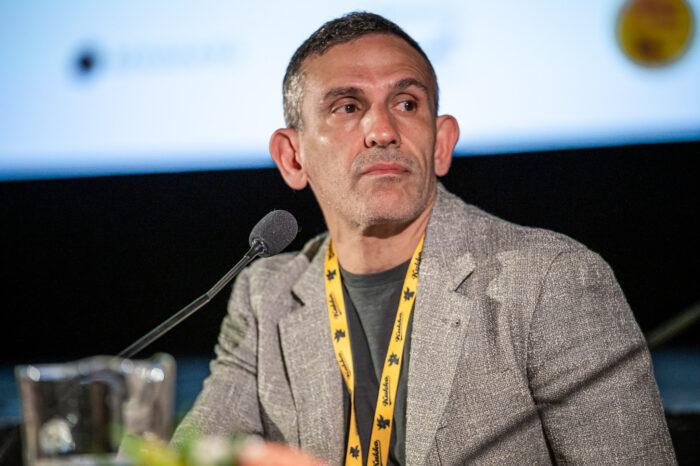On Thursday, the morning discussions began with Italian director Michelangelo Frammartino. Frammartino is known for depicting the symbiotic relationship between people, animals and plants. His movies also highlight the forgotten villages and majestic scenery of Southern Italy, where his grandparents hail from.
Frammartino himself grew up in Milan, Northern Italy, in the 1980s. The preceding 1970s were characterised by a sense of community as people took to the streets and protested often. On the other hand, the 80s brought on the economic depression that made the people return to their homes. The life became more family-oriented and Frammantino told that like other children, he spent a lot of time in front of the television. Going to the cinema was considered a luxury.
Working in the middle ground between documentary and art installation, Frammartino initially studied architecture but switched to Civica Scuola del Cinema film school. During the discussion, he said that he regards his studies in architecture more relevant to his career in film than his studies in film school. From architecture he learned the ethics of design; an architect designs a space where people will eventually live in. This is how Frammartino sees movies as well: “Cinema is a space that welcomes its audience in.”
He mentioned that he was jealous of the cinematographers in his film school as they could work physically with the cameras, whereas the directors were not allowed to touch them.
“Nowadays everything has become digitalised so the significance of the material has diminished. Cinema is in danger of becoming fully conceptual.” Frammartino told that he is also interested in people who work in film but come from a different field: “If for example a visual artist is given a movie camera, the results are unique.”
Frammartino’s first film The Gift (2003) is set in Southern Italy’s Calabria, where his grandparents are from. Frammartino was asked how the region differs from the north, and he highlighted the differing relationships between the inside and outside spaces. In Milan, the division is notable; in apartment buildings visitors had to ring a bell, take an elevator and knock on the door. On the other hand, in Calabria people could come in and ask for permission to visit afterwards. If you wanted milk, a shepherd with a goat would be called inside to milk the animal.
Similarly set in Calabria, Frammartino’s international breakthrough The Four Times (2010) stars a dog and goat kids. Animal characters cannot be fully controlled, and according to Frammartino it puts the director in the role of an observer and enabler. You must stay patient and still for long periods of time. “The aim is to create perfect choreographies but the content is unpredictable so it will never be perfect,” he said.
The Four Times explores the theme of reincarnation, which is not a part of the local, firm Catholic tradition. According to Frammartino many beliefs in Calabria are based on pagan worldview. Frammartino’s religious grandmother also believed that snakes are enchanted souls. “In Calabria items and things have a soul too,” Frammartino said.
The name The Four Times originates from a description written in the name of philosopher Pythagoras which claims a human to be formed out of four elements. The bone structure is mineral, the circulation alludes to flora, the ability to move to animals and the rational thought distinctively human. According to Pythagoras people have to learn to know themselves four times.
In the end of the discussion the topic turned to the director’s most recent film The Hole (2021). The partly documentary film tells the story of a deep cave found in Italy in the 1960s, and the group of researchers from Piedmont who studied it.
Frammartino was interested in Italy’s boom in the 60s. Back then the aims were high, Pirelli skyscraper built and Juri Gagarin travelled to space. At the same time one of the deepest holes in the world was explored in Italy. The dark movie is extraordinary as the only light in many scenes comes from the headlights of the characters. Through the film Frammartino almost became a cave researcher himself. “I make movies for a very long time and in the end I start resembling my subjects. While filming The Four Times I learned to herd goats.”
Picture: Juho Liukkonen
